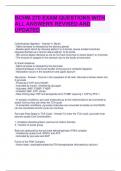BCHM 270 EXAM QUESTIONS WITH
ALL ANSWERS REVISED AND
UPDATED
Carbohydrate digestion - Answer-1) Mouth
- Alpha-amylase is released by the salivary glands
- Breaks apart starch by cleaving alpha(1 to 4) bonds, leaves smaller branched
oligosaccharides as it cannot cleave alpha(1 to 6) bonds
- We cannot digest cellulose as we do not have enzymes to cleave beta(1 to 4) bonds)
- The enzyme is stopped in the stomach due to the acidic environment
2) Small intestines
- Alpha-amylase is released by the pancreas
- Disaccharidases in the brush border of the jejunum complete digestion
- Absorption occurs in the duodenum and upper jejunum
Glycolysis - Answer-- Occurs in the cytoplasm of all cells- Glucose is broken down into
2 pyruvate
- Produces 2 ATP and 2 NADH
- Activated by insulin, inhibited by glucagon
- Activated: AMP, F26BP, F16BP
- Inhibited: G6P, ATP, citrate
- Rate limiting step: F6P and phosphate form F16BP requiring 1 ATP by PFK-1
- In aerobic conditions, pyruvate molecules go to the mitochondria to be converted to
acetyl-CoA so they can enter the TCA cycle
- In anaerobic conditions, pyruvate molecules are converted to lactate so that NADH
can be reoxidized and the cycle can continue
Pyruvate Prep Steps to TCA Cycle - Answer-To enter the TCA cycle, pyruvate must
become acetyl-CoA (irreversible!):
1. Oxidative decarboxylation (removal of carbon dioxide)
2. Transfer of acetyl group
Both are catalyzed by the pyruvate dehydrogenase (PDH) complex
- Inhibited by acetyl-CoA, NADH, and ATP
- Activated by pyruvate and ADP
Forms of the PDH Complex:
- Active state: unphosphorylated by PDH phosphatase (Activated by calcium)
,- Inactive state: phosphorylated by PDH kinase
(Activated by ATP, acetyl-CoA, NADH, inhibited by pyruvate, ADP, NAD+)
Gluconeogenesis - Answer-- Occurs in the mitochondria, cytoplasm, and ER in the liver
and kidneys
- Pyruvate, lactate, glycerol, and alpha-keto acids can all be converted to glucose
- Requires 4 ATP, 2 GTP, and 2 NADH
- Activated by glucagon, inhibited by insulin
- Activated: acetyl-CoA, citrate, ATP
- Inhibited: ADP, AMP, F26BP
- Rate limiting step: F16BP forms F6B by F16BPases
Types of glycogen - Answer-- Liver glycogen: maintains blood glucose levels during
initial stages of fasting
- Muscle glycogen: fuel reserve for ATP synthesis during muscle contraction
Structure of glycogen - Answer-- Branched-chain homopolysaccharide of alpha-D-
glucose
- After 8-10 molecules held together by alpha(1 to 4) linkage, there is a branch formed
by an alpha(1 to 6) linkage
Glycogen synthesis - Answer-- Occurs in liver and muscle tissue
- A chain of repeating glucose molecules is formed with UDP-glucose as the source of
glucose (a primer fragment of glycogen is required, the protein glycogenin can be used
instead)
- Activated by insulin, inhibited by glucagon
Glycogen breakdown - Answer-- Occurs in liver and muscle tissue
- Activated by glucagon, inhibited by insulin
- Activated: calcium, AMP
- Inhibited: G6P, ATP
PPP - Answer-- Occurs in various cells for NADPH-dependent processes
- G6P is converted to ribose 5-P
- Forms 2 NADPH
- Activated by insulin
- Inhibited: NADPH
Uses of NADPH - Answer-- Reductive agent
- Detoxifies ROS
- Kills phagocytosed bacteria
NADPH Hydrogen Peroxide detoxification - Answer-1.Hydrogen peroxide is reduced to
water while two molecules of oxidized glutathione are oxidized by glutathione
peroxidase
, 2. Oxidized glutathione is reduced to reduced glutathione by NADPH, catalyzed by
glutathione reductase
NADPH Killing phagocytosed bacteria - Answer-1. Electrons from NADPH are
transferred to oxygen to form superoxide by NADPH oxidase
2. Superoxide is converted to hydrogen peroxide
3. Hydrogen peroxide combines with chloride to form hypochlorous acid (bleach), which
kills bacteria
FAs (definition) - Answer-Hydrophobic hydrocarbon chain with a carboxyl group at the
end
FA naming - Answer-- Ionized at physiological pH, so amphipathic and name ends in -
ate
- Carbon adjacent to carboxyl group is alpha carbon, terminal carbon is the omega
carbon
- Most common: carboxyl carbon is C1, naming is number of carbons:number of double
bonds [cis/trans]-𝛥^number of carbons with double bonds
- Other way: omega carbon is C1, naming is 𝜔-number of carbons with double bonds
FA classification - Answer-Classified based on number of carbons:
- Short-chain FAs: fewer than 6 carbons
- Medium-chain FAs: 6-12 carbons
- Long-chain FAs: 13-21 carbons (require a carrier as they are hydrophobic)
- Very long-chain FAs: longer than 22 carbons (require special processing for
catabolism)
- Free FAs (FFAs): circulating in blood plasma
Also classified based on presence/absence of double bonds:
- Saturated: no double bonds
- Unsaturated: double bonds present
Nucleotides (definition) - Answer-basic structural unit for DNA and RNA (called a
nucleoside if they do not contain phosphate groups)
Nucleotides (structure) - Answer-1) Nitrogenous base
- Purines: two rings - adenine, guanine
- Pyrimidines: one ring - cytosine, uracil, thymine
- DNA uses adenine, guanine, cytosine, and thymine
- RNA uses adenine, guanine, cytosine, and uracil
2) 5-carbon sugar
- Deoxyribose: no hydroxyl group on the second carbon
- Ribose: hydroxyl group on the second carbon
- DNA uses deoxyribose
- RNA uses ribose




